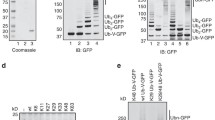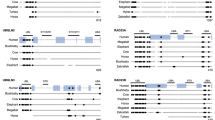Abstract
Ubiquitination is tightly regulated to control degradation, localization and function of various proteins. Ubiquitination is catalysed by three enzymes, namely E1, E2 and E3. The specificity shown by E2s for E3s holds key to regulation of ubiquitination. Here we focussed on the E2 enzymes, UBC4 and UBC5 of Saccharomyces cerevisiae, which are almost identical differing only by 11 residues. They show functional complementation in protein degradation, especially during stress response. Existence of two almost identical proteins suggests specialized requirement of one of them under selective conditions. To understand the reasons for the residue differences between them, mutations were introduced in the UBC4 gene to generate single residue variants by swapping with codons from UBC5. Though the variants are found to be functionally active in Δubc4Δubc5 strain of yeast, they cause reduced growth under normal conditions, altered survival under heat and antibiotic stresses, when compared with UBC4. The variants indicated decrease in protein stability theoretically. Hence, the residues of UBC5 individually do not confer any structural advantage to UBC4. Interactive proteins of UBC4 are nearly three times more than those of UBC5. UBC5, therefore, is a functionally minimized version, evolved as another means of regulation to meet cell stage specific needs.







Similar content being viewed by others
References
Wu, R. S., Kohn, K. W., & Bonner, W. M. (1981). Metabolism of ubiquitinated histones. Journal of Biological Chemistry, 256, 5916–5920.
Ball, E., Karlik, C. C., Beall, C. J., Saville, L., Sparrow, J. C., Bullard, B., et al. (1987). Arthrin, a myofibrillar protein of insect flight muscle, is an actin-ubiquitin conjugate. Cell, 51, 221–228.
Spence, J., Gali, R. R., Dittmar, G., Sherman, F., Karin, M., & Finley, D. (2000a). Cell cycle regulated modification of the ribosome by a variant multiubiquitin chain. Cell, 102, 67–76.
Arnason, T., & Ellison, M. J. (1994). Stress resistance in Saccharomyces cerevisiae is strongly correlated with assembly of a novel type of multiubiquitin chain. Molecular and Cellular Biology, 14, 7876–7883.
Finley, D., Ozkaynak, E., & Vasrshavsky, A. (1987). The yeast polyubiquitin gene is essential for resistance to high temperatures, starvation, and other stresses. Cell, 48, 1035–1046.
Morvan, J., Froissard, M., Tsapis, R. H., & Grimal, D. U. (2004). The Ubiquitin Ligase Rsp5p is required for modification and sorting of membrane proteins into multivesicular bodies. Traffic, 5, 383–392.
Reggiori, F., & Pelham, H. R. B. (2002). A transmembrane ubiquitin ligase required to sort membrane proteins into multivesicular bodies. Nature Cell Biology, 4, 117–123.
Kleiger, G., & Mayor, T. (2014). Perilous journey: a tour of the ubiquitin–proteasome system. Trends in Cell Biology, 24, 352–359.
Finley, D., Ulrich, H. D., Sommer, T., & Kaiser, P. (2012). The ubiquitin-proteasome system of Saccharomyces cerevisiae. Genetics, 192, 319–360.
Finley, D., & Chau, V. (1991). Ubiquitination. Annual Review of Cell Biology, 7, 25–69.
Hershko, A., & Ciechanover, A. (1998). The ubiquitin system. Annual Review of Biochemistry, 67, 425–479.
Ye, Y., & Rape, M. (2009). Building ubiquitin chains: E2 enzymes at work. Nature Reviews Molecular Cell Biology, 10, 755–764.
Bedford, L., Lowe, J., Dick, L. R., Mayer, R. J., & Brownell, J. E. (2011). Ubiquitin-like protein conjugation and the ubiquitin-proteasome system as drug targets. Nature Reviews Drug Discovery, 10, 29–46.
Harper, J. W., & King, R. W. (2011). Stuck in the middle: drugging the Ubiquitin system at E2 step. Cell, 145, 1007–1009.
Ceccarelli, D. F., Tang, X., Pelletier, B., Orlicky, S., Xie, W., Plantevin, V., et al. (2011). An allosteric inhibitor of the human Cdc34 ubiquitin-conjugating enzyme. Cell, 145, 1075–1087.
Skaar, J. R., & Pagano, M. (2009). Control of cell growth by the SCF and APC/C ubiquitin ligases. Current opinion in Cell Biology, 21, 816–824.
Cook, W. J., Jeffrey, L. C., Xu, Y., & Chau, V. (1993). Tertiary structures of Class I ubiquitin-conjugating enzymes are highly conserved: crystal structure of yeast Ubc4. Biochemistry, 32, 13809–13817.
Seufert, W., & Jentsch, S. (1990). Ubiquitin-conjugating enzymes UBC4 and UBC5 mediate selective degradation of short-lived and abnormal proteins. EMBO Journal, 9, 543–550.
Chuang, S.-M., & Madura, K. (2005). Saccharomyces cerevisiae Ub-conjugating enzyme Ubc4 binds the proteasome in the presence of translationally damaged proteins. Genetics, 171, 1477–1484.
Seufert, W., Mcgrath, J. P., & Jentsch, S. (1990). UBC1 Encodes a novel member of an essential subfamily of yeast ubiquitin-conjugating enzymes involved in protein degradation. EMBO Journal, 9, 4535–4541.
Mishra, P., Volety, S., Rao, Ch,M., & Prabha, C. R. (2009). Glutamate64 to glycine substitution in G1 beta-bulge of ubiquitin impairs function and stabilizes structure of the protein. The Journal of Biochemistry, 146, 563–569.
Prabha, C. R., Mishra, P., & Shahukar, M. (2010). Isolation of a dosage dependent lethal mutation in ubiquitin gene of Saccharomyces cerevisiae. Macromolecular Symposia, 287, 87–94.
Mishra, P., Prabha, C. R., Rao Ch, M., & Volety, S. (2011). Q2N and S65D substitutions of ubiquitin unravel functional significance of the invariant residues Gln2 and Ser65. Cell Biochemistry and Biophysics, 61, 619–628.
Sharma, M., & Prabha, C. R. (2011). Construction and functional characterization of double and triple mutants of parallel beta-bulge of ubiquitin. Indian Journal of Experimental Biology, 49, 919–924.
Sharma, M., & Prabha, C. R. (2015). Q2N and E64G double mutation of ubiquitin confers a stress sensitive phenotype on Saccharomyces cerevisiae. Indian Journal of Experimental Biology, 53, 617–620.
Doshi, A., Mishra, P., Sharma, M., & Prabha, C. R. (2014). Functional characterization of dosage-dependent lethal mutation of ubiquitin in Saccharomyces cerevisiae. FEMS Yeast Research, 14, 1080–1089.
Doshi, A., Sharma, M., & Prabha, C. R. (2017). Structural changes induced by L50P and I61T single mutations of ubiquitin affect cell cycle progression while impairing its regulatory and degradative functions in Saccharomyces cerevisiae. International Journal of Biological Macromolecules, 99, 128–140.
Oughtred, R., Chatr-Aryamontri, A., Breitkreutz, B. J., Chang, C. S., Rust, J. M., & Theesfeld, C. L., et al. (2016). BioGRID: a resource for studying biological interactions in yeast. Cold Spring Harbor Protocols, 2016, pdb.top080754.
Oughtred, R., Stark, C., Breitkreutz, B. J., Rust, J., Boucher, L., Chang, C. et al. (2019). The BioGRID interaction database: 2019 update. Nucleic Acids Research, 47(D1), D529–D541.
Pires, D. E. V., David, B. A., & Blundell, T. L. (2014). mCSM: predicting the effects of mutations in proteins using graph-based signatures. Bioinformatics, 30, 335–342.
Chen, P., Johnson, P., Sommer, T., Jentsch, S., & Hochstrasser, M. (1993). Multiple ubiquitin-conjugating enzymes participate in the in vivo degradation of the yeast MAT α 2 repressor. Cell, 74, 357–369.
Finley, D., Ozkaynak, E., & Varshavsky, A. (1987a). The yeast polyubiquitin gene is essential for resistance to high temperatures, starvation, and other stresses. Cell, 48, 1035–1046.
Finley, D., Sadis, S., Monia, B. P., Boucher, P., Ecker, D. J., Crooke, S. T et al. (1994). Inhibition of proteolysis and cell cycle progression in a multiubiquitination-deficient yeast mutant. Molecular and Cellular Biology, 14, 5501–5509.
Chen, D. C., Yang, B. C., & Kuo, T. T. (1992). One-step transformation of yeast in stationary phase. Current Genetics, 21, 83–84.
Wijk, S. J., Melquiond, A., Vries, S. J., Timmers, S., & Bonvin, A. (2012). Dynamic Control of Selectivity in the Ubiquitination Pathway Revealed by an ASP to GLU Substitution in an Intra-Molecular Salt-Bridge Network. PLoS Computational Biology, 8(11), e1002754.
Chou, P. Y., & Fasman, G. D. (1974). Conformational parameters for amino acids in helical, β-Sheet and random coil regions calculated from proteins. Biochemistry, 13, 211–222.
Hopp, T. P., & Woods, K. R. (1981). Prediction of protein antigenic determinants from amino acid sequences. Proceedings of the National Academy of Sciences, 78, 3824–3828.
Betts, M. J., & Russell, R. B. (2003). Amino acid properties and consequences of substitutions, In R. B. Michael & C. G. Ian (eds), Bioinformatics for geneticists (pp. 289–316). John Wiley & Sons, Ltd.
Hutchinson, E. G., & Thornton, J. M. (1994). A revised set of potentials for β-turn formation in proteins. Protein Science, 3, 2207–2216.
Szklarczyk, D., Morris, J. H., Cook, H., Kuhn, M., Wyder, S., Simonovic, M. et al. (2017). The STRING database in 2017: quality-controlled protein-protein association networks, made broadly accessible. Nucleic Acids Research, 45(Database issue), D362–D368.
Acknowledgements
The authors express their sincere gratitude to Prof. Stefan Jentsch of Max Planck Institute of Biochemistry, Germany, for the plasmid carrying UBC4 gene and Prof. Mark Hochstrasser of Yale University, New Haven, CT, USA, for providing the S. cerevisiae strains MHY501 and MHY508. V.R. and B.P. were supported by University Fellowship of The M. S. University of Baroda, Vadodara, India.
Author information
Authors and Affiliations
Corresponding author
Ethics declarations
Conflict of Interest
The authors declare that they have no conflict of interest.
Additional information
Publisher’s note Springer Nature remains neutral with regard to jurisdictional claims in published maps and institutional affiliations.
Supplementary information
Rights and permissions
About this article
Cite this article
Raimalani, V., Panchamia, B. & Prabha, C.R. Construction and Characterization of UBC4 Mutants with Single Residues Swapped from UBC5. Cell Biochem Biophys 78, 43–53 (2020). https://doi.org/10.1007/s12013-019-00894-1
Received:
Accepted:
Published:
Issue Date:
DOI: https://doi.org/10.1007/s12013-019-00894-1




